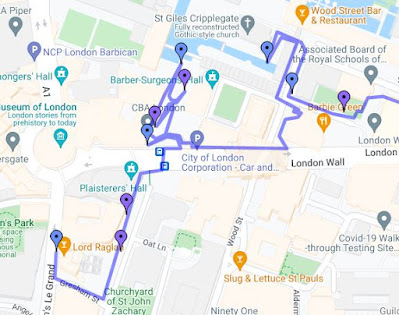 |
| The London Wall at St. Alphage Garden |
During my very brief investigation of the churchyard of St. Giles Cripplegate, I could hardly miss the remains of the London Wall – with the foundations of a bastion – that lie on the other side of a water feature to the immediate south of the church.
This section originally formed the northern side of the Roman fort, built c AD 120 in Kentish Rag stone from Maidstone in Kent. In the C13, during the rebuilding of the wall, a series of towers were added and most of the surviving masonry dates to this period.
When preparing my walk, the best route along the London Wall that I found was produced by the Museum of London back in 1984 and, following the London Wall Walk, I retraced my steps back to St. Alphage Garden.
A good section is exposed here, with Roman remains excavated from beneath the current street level being succeeded by mediaeval repairs and an upper section in brick, with crenellations and diapers, was added in 1477.
I didn’t have a good look at the masonry, but the lowest Roman part of the wall is predominantly built out of Kentish Rag rubble stone, with occasional nodules of flint and red tile – bound together by a lime mortar containing gravel sized aggregate.
Several sites have long since disappeared and are marked by very informative and well made ceramic information panels, as at Cripplegate, but some of these have been removed and I therefore concentrated on taking photos rather than seeking out the panels.
Moving on to the remaining north tower of the West Gate of the Roman Fort, which is set next to the access road to an underground car park, the first impression is of a large brick structure, with a fragment of Kentish Rag walling attached to it. The tower was lined in brick when used as a warehouse in the C19, but its northern part still retains a good section of original rubble walling.
The wall continues north until it is interrupted by the Barber-Surgeons' Hall tower, where only the lower section of the rubble wall remains. There is not much to see here and I continued to the St. Giles Cripplegate tower, which marked the north-west corner of the London Wall, but has been reduced to two thirds of its original height.
The last section of the wall that I visited runs alongside Noble Street, with much of the remains appearing as footings that are barely visible amongst the wildflowers, which have been planted in the Noble Street Garden.
Although this is the least impressive part of the wall, with some sections retaining unsightly brickwork left from demolished C19 buildings, there are still substantial stretches of rubble walling that include some Roman work. With my investigation of the London Wall completed, I made my way to the Museum of London.










No comments:
Post a Comment